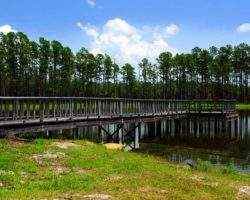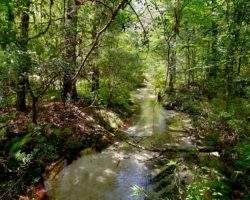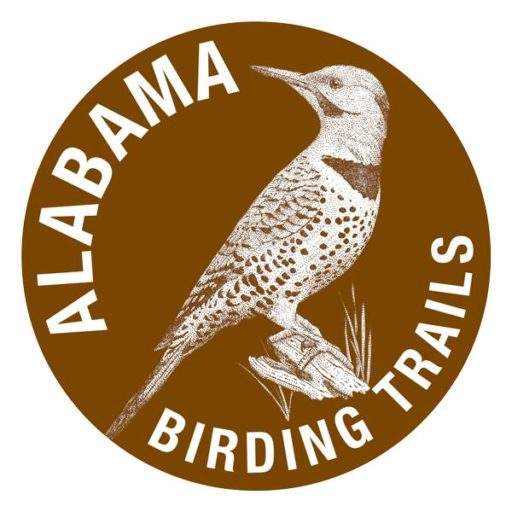Wiregrass | Covington | Best Seasons: Fall | Spring | Winter
Florala City Wetland Park (formerly Florala State Park) combine to offer visitors a variety of ways to explore and enjoy the northern portion of 500-acre Lake Jackson. The State Park offers picnic tables and a picnic shelter, a campground, public beaches, a pier, and a paved walking trail. Just a short distance along the shoreline, Florala City Wetland Park offers elevated boardwalks through Spanish Moss-draped Cypress forest and Palmetto scrub along the edge of the lake.
In the more developed portion of the park, formerly the State Park area, resident birds include Northern Cardinals, Northern Mockingbirds, Brown Thrashers, and Downy and Red-bellied Woodpeckers. Great Blue Herons, Great Egrets, and Green Herons are also year round residents here. From late March until October, Northern Parulas and Orchard Orioles are quite common in the Cypress trees, and Yellow-throated Warblers and American Redstarts are also numerous. In the warmer months, the Palmetto scrub may attract a few Painted Buntings. Common Yellowthroats, White-eyed Vireos, and Indigo Buntings are more reliable. Red-headed Woodpeckers are conspicuous all year.
Osprey often fish the lake here, and Bald Eagles are fairly regular visitors. Search the water and the exposed branches for Anhingas. Some gulls are present in the winter, and some diving ducks may also be present from November through March. Search the rafts of American Coots for Common Moorhens.
At the southwest end of the former Florala State Park, follow the sign to Florala Wetland Park, a long, elevated boardwalk that transports visitors over a dense wet tangle of Clethra, Itea, Anise, Ti-ti, and many other wetland-loving species, all growing beneath a canopy of tall pines and hardwoods. You’ll find tons of birds here — from Common Yellowthroats, Louisiana Waterthrushes, Northern Parulas, American Redstarts, Yellow-throated Warblers, a few Swainson’s Warblers, and Pine Warblers. The boardwalk leads to two covered piers overlooking Lake Jackson. These are good places to scan through the rafts of waterfowl and flocks of gulls in winter, and to check the Cypress trees on the edges for songbirds, as well as perched Ospreys, Bald Eagles, and Anhingas.
These sites can be very productive in migration, and winter bird activity is generally high. Sightlines vary. Visibility in the cypress forests of the state park is exceptionally good, while the wetland park is much more difficult to see in. Work on learning the songs.
GPS: 31.0027462 -86.3262676
Florala State Park
514 Lake Shore Dr
Florala, AL 36442
334-858-6425
Site Accessibility
There is an extensive paved trail along the shore of the lake, offering good views of the shoreline, lots of ducks in the winter, and access to the wooded areas year round.
From the intersection of US 331 and AL 55 in Florala (Covington County – fuel, food, and lodging available), follow AL 55 S/US 331 E eastbound for 3 blocks to the intersection of 3rd Street and 5th Avenue. Turn south to follow AL 55 S for a long block to Lakeshore Avenue. The state park rings the lake here; the wetland park is a block ahead on AL 55 S/3rd Street. The parking lot is on the left (east) side of the road.
Amenities Available: Boat Launch, Gravel or Dirt Trails, Paved Trails, Picnic Tables, Restrooms, Wheelchair Accessible
Nearby Sites

Conecuh National Forest
The 83,000 acres of the Conecuh National Forest house scores of Red-cockaded Woodpecker colonies and hundreds of Bachman’s Sparrows in the pine forests. You’ll find breeding Anhingas, Purple Gallinules, Common Moorhens, King Rails, and Least Bitterns …

Frank Jackson State Park
Frank Jackson State Park is a 2,050-acre park centered on 1,000-acre Lake Frank Jackson, and offers boating, fishing, swimming, hiking, camping, and picnicking. There are also a number of nature trails and boardwalks providing access to islands and m …

Solon Dixon Forestry Education Center
The Solon Dixon Forestry Education Center in the Conecuh National Forest is operated by Auburn University and hosts classes and conducts research projects throughout the year. The 5,300-acre tract offers a tremendous diversity of plants, many of whic …
